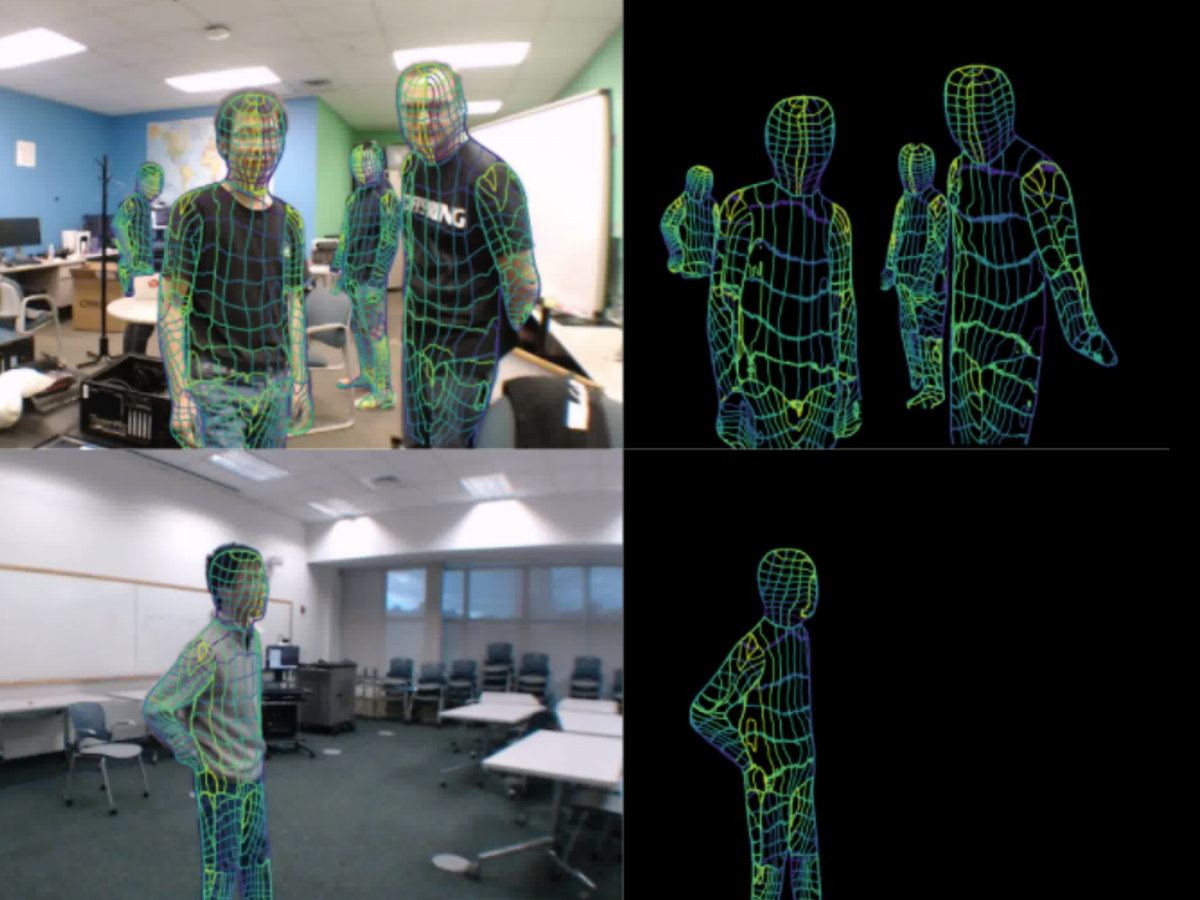AI can ‘see’ people through walls using WiFi signals
‘This technology may be scaled to monitor the well-being of elderly people or just identify suspicious behaviours at home,’ scientists claim
Scientists have figured out how to identify people in a building by using artificial intelligence to analyse WiFi signals.
A team at Carnegie Mellon University developed a deep neural network to digitally map human bodies when in the presence of WiFi signals.
The researchers said they developed the technology in an effort to address the limitations of current 2D and 3D computer vision tools like cameras, Lidar and radars.
A pre-print study of the technology describes how the system “can serve as a ubiquitous substitute” for these other methods.
“The results of the study reveal that our model can estimate the dense pose of multiple subjects, with comparable performance to image-based approaches, by utilising WiFi signals as the only input,” the researchers wrote in the study.
“This paves the way for low-cost, broadly accessible, and privacy-preserving algorithms for human sensing.”
The researchers used a system called DensePose, which was developed by AI researchers at Meta’s Facebook, to measure the phase and amplitude signals emitted from WiFi routers.
The WiFi-based model is currently limited to 2D models of people, however the researchers hope to keep developing it in order to be able to predict 3D human shapes.
The team claims the device offers a cheap and “privacy-friendly” alternative to cameras and Lidars, as it does not provide a clear image of the subject.Potential applications include assisting elderly people, the scientists noted, allowing them to continue to live independently.
“We believe that WiFi signals can serve as a ubiquitous substitute for RGB [camera] images for human sensing in certain instances,” they wrote.
Scientists find way to photograph people through walls using WiFi
The technology can be used to map out the inside of a building in 20 to 30 seconds
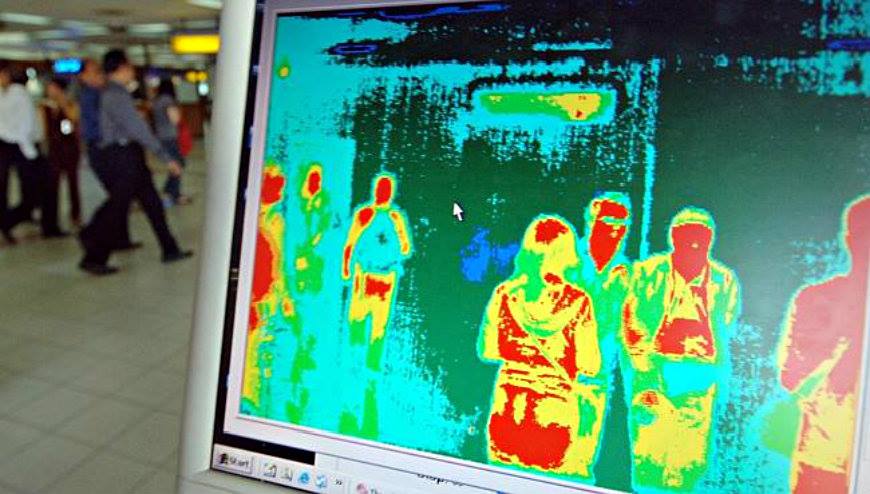
Scientist at the Technical University of Munich have come up with a new technology that can take 3D photographs of objects inside a room or building using WiFi.
The research, which was published by Physical Review Letters, shows that wireless data transmission systems including WiFi or Bluetooth emit electromagnetic waves with a precisely known amplitude and phase which can be used to map objects in their surroundings.
“Propagating in space, this radiation forms a hologram — a two-dimensional wave front encoding a three-dimensional view of all objects traversed by the light beam. Three-dimensional views of objects and emitters are made by feeding the resulting data into digital reconstruction algorithms,” Philip Holls and Friedemann Reinhard noted in their report.
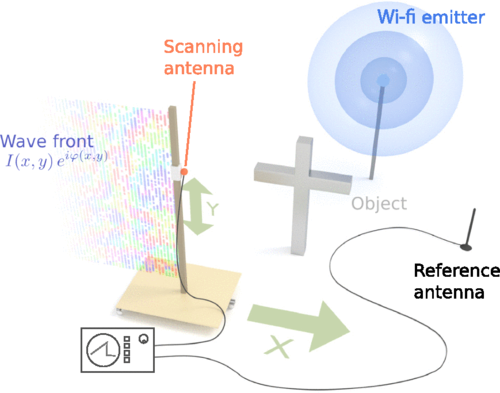
PHOTO: Philip Holls and Friedemann Reinhard/Physical Review Letters
The two scientist went on to test their ground breaking technology in an experimental environment. Stray radiation from a commercial router was employed to image metre-sized objects by digital holography. The researchers then record a hologram of WiFi radiation by using a synthetic aperture approach.
The scientist then employ digital implementation of dark-field propagation to suppress multipath reflection, which significantly enhances the quality of the resulting images.
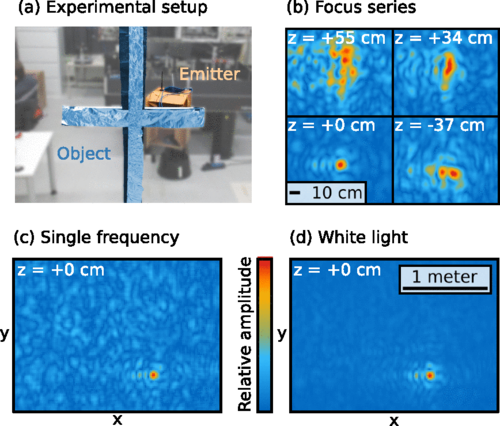
PHOTO: Philip Holls and Friedemann Reinhard/Physical Review Letters
“It can basically scan a room with someone’s WiFi transmission,” said Holl, a 23-year-old undergraduate physics student at the Technical University of Munich. He initially built the device as part of his bachelor thesis with the help of his academic supervisor, Friedemann Reinhard.
“If there’s a cup of coffee on a table, you may see something is there, but you couldn’t see the shape,” said Holl. “But you could make out the shape of a person, or a dog on a couch. Really any object that’s more than four centimetres in size.”
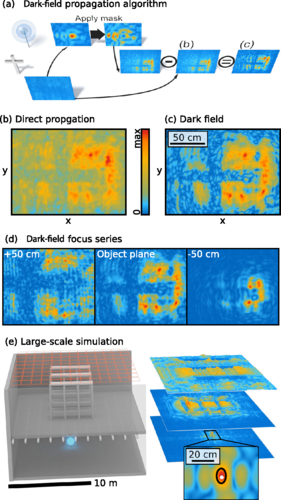
PHOTO: Philip Holls and Friedemann Reinhard/Physical Review Letters
The technology, which is at its early stages, has application in a wide range of areas. Adding an array of reference antennas, said Holl, inside a truck, might help rescue workers detect people in rubble left by an earthquake or spy agencies see whether anyone is home.
“You could probably use a drone to map out the inside of an entire building in 20 to 30 seconds,” he said. source
MIT’s AI can now ‘see’ and track people through walls using wireless signals
The creepy RF-Pose system developed by MIT’s CSAIL can track a person through walls or identify one specific person out of a group of 100 people.

MIT has created a system likened to X-ray vision, but the AI can track a person through walls — or identify one specific person out of a group of 100 people — by using wireless signals. MIT’s Computer Science and Artificial Intelligence Laboratory (CSAIL) calls it RF-Pose.
Yeah, that’s not creepy at all. How could they ignore the blaring red alert of potential privacy and spying issues and continue to develop artificial intelligence (AI) that can monitor a person’s movements through a solid wall using wireless radio waves? Apparently for its potential use in healthcare.
According to MIT News:
The team says that RF-Pose could be used to monitor diseases like Parkinson’s, multiple sclerosis (MS), and muscular dystrophy, providing a better understanding of disease progression and allowing doctors to adjust medications accordingly. It could also help elderly people live more independently, while providing the added security of monitoring for falls, injuries and changes in activity patterns. The team is currently working with doctors to explore RF-Pose’s applications in health care.
The research paper, “Through-Wall Human Pose Estimation Using Radio Signals” (pdf) calls RF-Pose “a solution that leverages radio signals to accurately track the 2D human pose through walls and obstructions.”
As pointed out on MIT News:
Besides sensing movement, the authors also showed that they could use wireless signals to accurately identify somebody 83 percent of the time out of a line-up of 100 individuals. This ability could be particularly useful for the application of search-and-rescue operations, when it may be helpful to know the identity of specific people.
Other potential uses cited include using RF-Pose “for new classes of video games where players move around the house, or even in search-and-rescue missions to help locate survivors.”
The system counted on the fact that wireless signals in Wi-Fi frequencies are not stopped by solid walls and can reflect off a person’s body. The team used AI “to teach wireless devices to sense people’s postures and movement, even from the other side of a wall. The researchers use a neural network to analyze radio signals that bounce off people’s bodies and can then create a dynamic stick figure that walks, stops, sits, and moves its limbs as the person performs those actions.”
Future plans for RF-Pose
The CSAIL minds behind RF-Pose are currently working on 3-D output instead of the current 2-D stick figure output. 3D could show “even smaller micromovements,” such as seeing “if an older person’s hands are shaking regularly enough that they may want to get a check-up.” They see it as a plus that patients would not be required to wear sensors or to charge devices.
Down the road at some point, CSAIL plans to develop a “consent mechanism” as a technical countermeasure to block surveillance. It would involve a person doing “a specific set of movements in order for it to being to monitor the environment.” source
Scientists Can Now Use WiFi to See Through People’s Walls
- Researchers at Carnegie Mellon University can map human bodies through walls using WiFi signals.
- The technology tracks key points on the body for detection, extending previous research into using WiFi signals to locate humans.
- The study’s authors position the breakthrough as helpful to privacy, even if it opens the possibilities for much easier, cheaper human tracking.
It isn’t immediately clear how using only a WiFi signal to track human movement through walls improves personal privacy … but that’s what a new study from Carnegie Mellon University claims.
In a recently published paper, the researchers expanded on the study of employing WiFi signals to map human movement, especially in low-light situations that make using other technologies less than desirable. They write:
“We developed a deep neural network that maps the phase and amplitude of WiFi signals to UV coordinates within 24 human regions. The results of the study reveal that our model can estimate the dense pose of multiple subjects, with comparable performance to image-based approaches, by utilizing WiFi signals as the only input.”
This pathway opens the options for low-cost, broadly accessible human tracking through walls.
High-cost technology has successfully mapped people’s movements through walls for years. And researchers at the Massachusetts Institute of Technology have spent over a decade working on ways to more easily see people through walls, whether using cell phone signals or WiFi. In the Carnegie Mellon study, scientists had WiFi signals send and receive a body’s coordinates and then used DensePose to map the body.
From the study:
“Advances in computer vision and machine learning techniques have led to significant development in 2D and 3D human pose estimation from RGB cameras, LiDAR, and radars. However, human pose estimation from images is adversely affected by occlusion and lighting, which are common in many scenarios of interest.”
By reducing the need for the advanced—and expensive—technology, the Carnegie Mellon researchers say they can make human tracking more available. Somehow, they’ve also positioned the breakthrough as a privacy-positive situation. You don’t need WiFi signals to see that’s a bit sketchy. source
AI Learns How to Use Wi-Fi Signals to See People Through Walls
Scientists have found a way to use artificial intelligence and WiFi signals to recognize people in a building, just like James Bond.
A team at Carnegie Mellon University created a deep neural network that can map human bodies using WiFi signals.
The researchers developed this technology to overcome the limitations of current 2D and 3D computer vision tools.
In a study, they explained that their model can accurately estimate the positions of multiple people using only WiFi signals.
They hope that this breakthrough will lead to affordable, widely available, and privacy-friendly algorithms for detecting humans.
AI can ‘see’ people through walls using WiFi signals
Scientists have figured out how to identify people in a building by using artificial intelligence to analyse WiFi signals.
A team at Carnegie Mellon University developed a deep neural network to digitally map human bodies when in the presence of WiFi signals.
The researchers said they developed the technology in an effort to address the limitations of current 2D and 3D computer vision tools like cameras, Lidar and radars.
A pre-print study of the technology describes how the system “can serve as a ubiquitous substitute” for these other methods.
“The results of the study reveal that our model can estimate the dense pose of multiple subjects, with comparable performance to image-based approaches, by utilising WiFi signals as the only input,” the researchers wrote in the study.
“This paves the way for low-cost, broadly accessible, and privacy-preserving algorithms for human sensing.”
The researchers used a system called DensePose, which was developed by AI researchers at Meta’s Facebook, to measure the phase and amplitude signals emitted from WiFi routers.
The WiFi-based model is currently limited to 2D models of people, however the researchers hope to keep developing it in order to be able to predict 3D human shapes.
The team claims the device offers a cheap and “privacy-friendly” alternative to cameras and Lidars, as it does not provide a clear image of the subject.
Potential applications include assisting elderly people, the scientists noted, allowing them to continue to live independently.
“We believe that WiFi signals can serve as a ubiquitous substitute for RGB [camera] images for human sensing in certain instances,” they wrote.
“Most households in developed countries already have WiFi at home, and this technology may be scaled to monitor the well-being of elderly people or just identify suspicious behaviours at home.” source
This neural network uses WiFi to see through walls
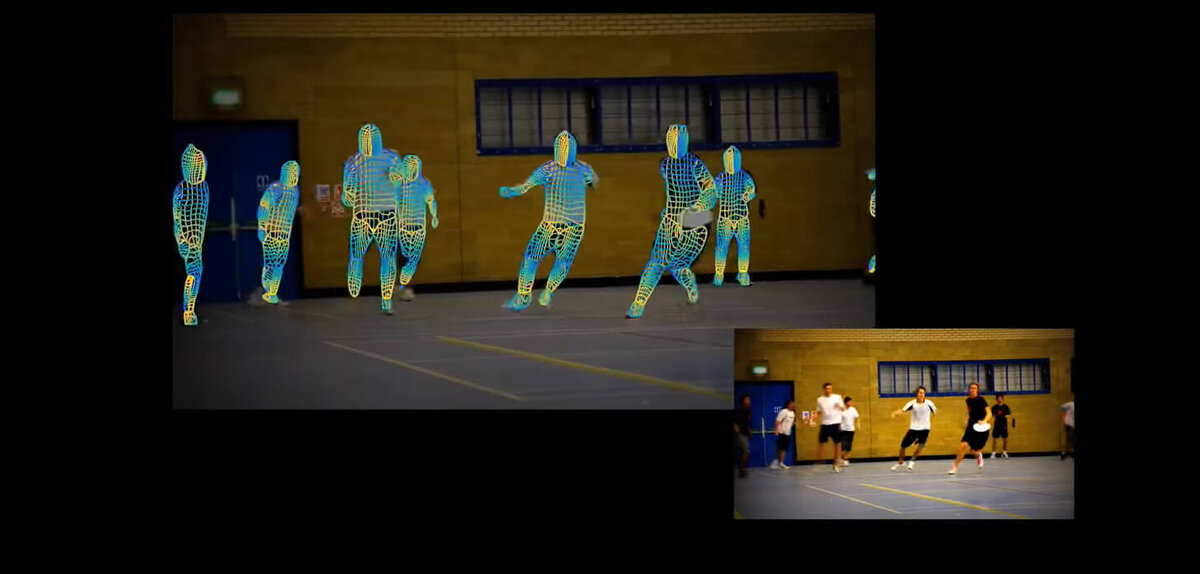
“Yes, a simple WiFi signal can be used to spy on us through walls, a scary thought for people who value their privacy”, Nigel elaborates.
Seeing through walls is an ability most people associate with Superman’s X-ray vision or James Bond’s X-ray sunglasses but scientists at Carnegie Mellon University have come up with a way to see through walls using a neural network and WiFi signals. While previous efforts by MIT researchers used radio waves to see through walls, the images were typically low resolution and difficult to use to identify people.
WiFi signals, however, are apparently even better than regular RGB cameras for detecting humans and can be hooked up to a neural network in order to create a 3D map of a human body standing on the other side of a wall. Yes, a simple WiFi signal can be used to spy on us through walls, a scary thought for people who value their privacy.
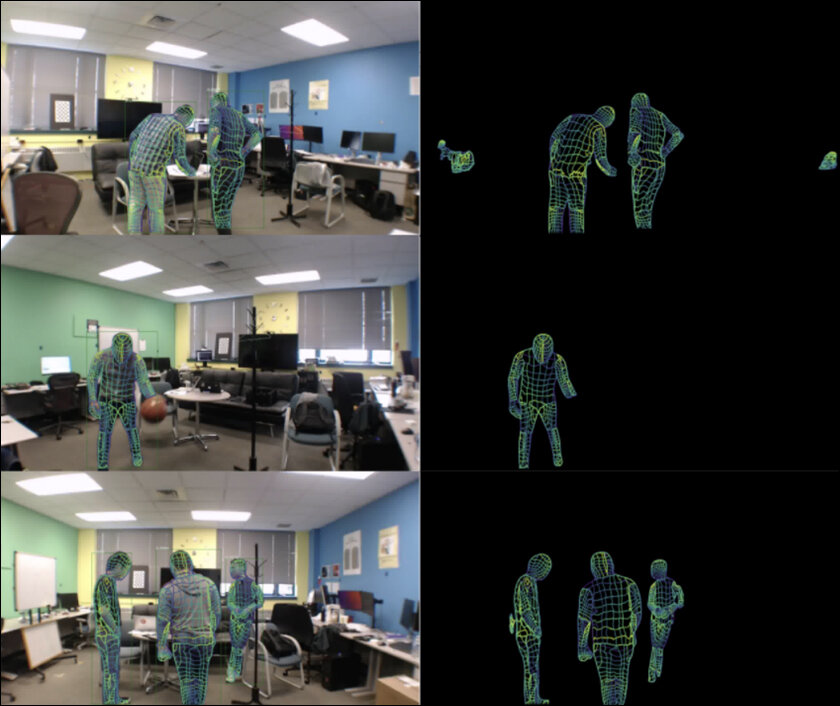
WiFi Vision
As opposed to a camera that works on the principles of light and visibility, this innovation sends a low-powered WiFi signal through a wall in order to detect everything in the room on the other side of it. It does this much like a radar signal that bounces off static objects to detect movement. In the case of human bodies, the WiFi signal sends the coordinates of key points on the human body like the head, arms, and legs (that determine posture) which are then fed into a system called DensePose which assimilates them into a 3D picture. DensePose is a deep neural network that can map all the pixels from a 2D RGB image of the human body and convert them to a 3D image.
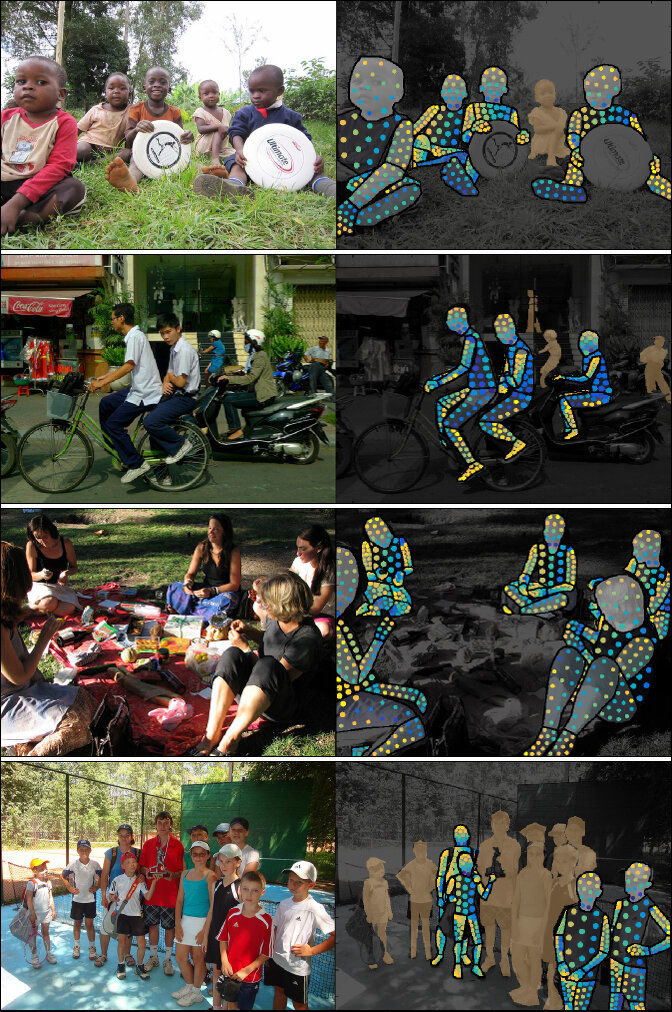
Developed by a team of researchers from London along with Facebook’s AI team, the process involves establishing a “dense” correspondence between a 2D image and a 3D surface model. In this case, however, it’s not 2D images that are being mapped but rather the results of a WiFi-powered scan that is being mapped to a 3D image.
The efficiency and accuracy of details are quite astounding as you can see in some images on the DensePose website. While this explanation could be interpreted by some to be overly simplified since there’s quite a lot of mathematics involved in this process of “pose estimation,” the short version is that the technology does work and will only require off-the-shelf WiFi equipment to use.
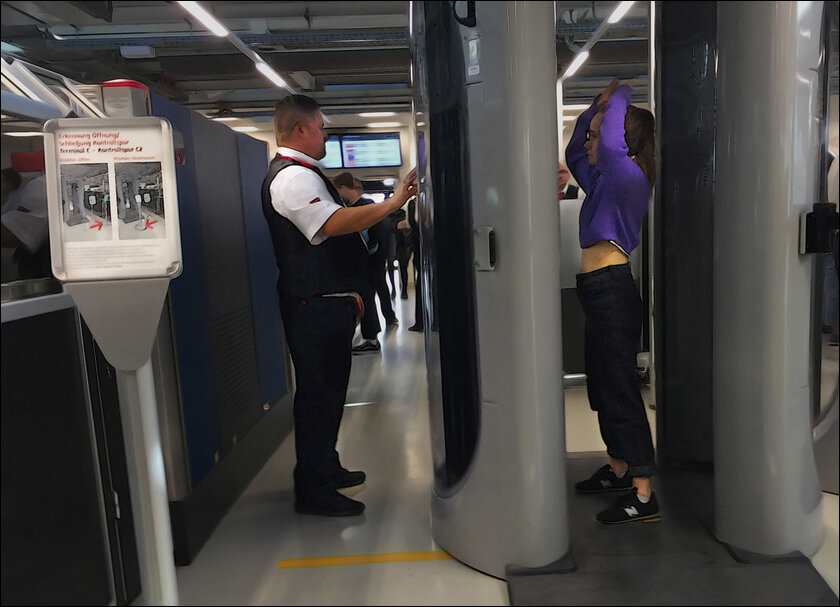
Security Implications
Now while researchers argue that this innovation could be progress for privacy rights since we won’t need cameras everywhere anymore, that’s sort of like making the TV remote shoot lasers and then saying the good part is we don’t need guns anymore. If every lunatic that could get their hands on a TV remote could use it to blast things out of their way, there wouldn’t be a lot of things left to blast. Similarly, if every nosey person could use a WiFi router to see through walls, it would officially be the end of privacy, can you imagine if the paparazzi got their hands on something like this? No one would be safe, especially since walls are something most people expect to be able to rely on for privacy.
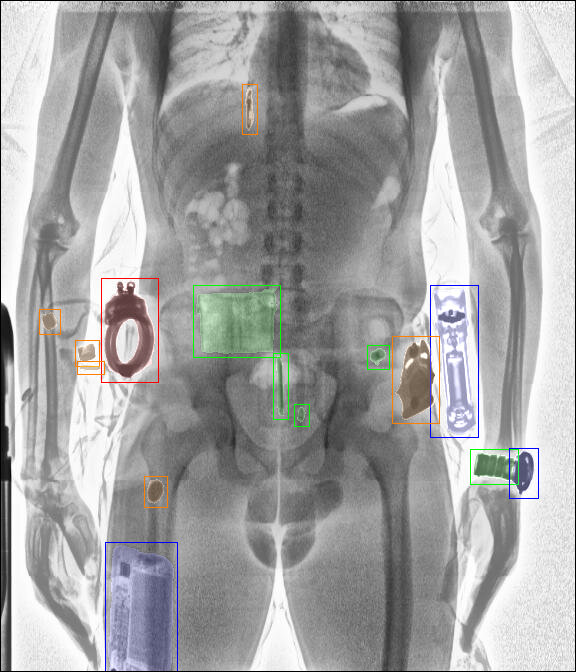
Now while there is always an upside to new technology like the potential to use it for law enforcement or even home security purposes, like in the case of nuclear technology, it always cuts both ways. Researchers at Waterloo University have devised a way to use WiFi to see through walls using a store-bought drone and an additional $20 worth of store-bought equipment.
While the Wi-Peep doesn’t have a fancy 3D mapping application powering it, what it does have is a security loophole called Polite WiFi. What this means is that every WiFi-powered device, even secure, will respond to contact attempts from other devices in range. These responses are then used to track and locate the wearers of these devices or the devices themselves.
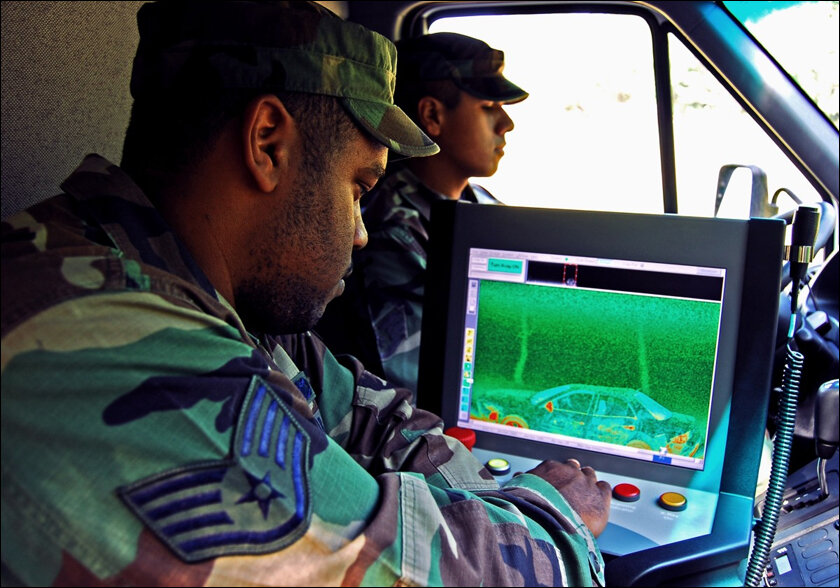
X-ray Vision
With the amount of data we generate on a daily basis, there are those who would argue that our phones already know more about us than we possibly ever could. That being said, however, the possibility of being spied on every time you operate a WiFi device might be something we may just have to get used to in the future. In addition to walls, WiFi also overcomes a number of obstacles like poor lighting, occlusion, or even the need for a camera.
There’s no argument that it would be great for the armed forces and covert military operations where knowledge of the insides of enemy buildings is generally hard to come by unless you have someone inside. If X-ray vision is a superpower we are going to have soon, we may as well enjoy it. As for privacy, for all we know, it may already be dead. source
WiFi routers can see people through walls. Here’s how it works
With the help of AI, the researchers were able to detect the movement of human bodies in a room using Wi-Fi routers — even through walls.
Researchers at Carnegie Mellon University have repurposed a common piece of tech found inn virtually every household into a tracking technology.
They used radio signals from WiFi routers to detect and track the three-dimensional shape and movements of human bodies in a room. They didn’t have to use any cameras or expensive LiDAR hardware.
“We believe that WiFi signals can serve as a ubiquitous substitute for RGB images for human sensing in certain instances. Illumination and occlusion have little effect on WiFi-based solutions used for interior monitoring. In addition, they protect individuals’ privacy and the required equipment can be bought at a reasonable price. In fact, most households in developed countries already have WiFi at home, and this technology may be scaled to monitor the well-being of elder people or just identify suspicious behaviors at home,” the authors wrote in their study, which is yet to be formally peer-reviewed and is available on the preprint server ArXiv.
AI turns WiFi routers into cameras that can see through walls
The team used DensePose, a system for mapping all of the pixels on the surface of a human body in a photo, developed by researchers at Facebook’s AI lab and a London-based team. What makes DensePose powerful is its ability to identify over two dozen key points and areas in the human body, such as joints and body parts like the arms, head, and torso. This allows the AI to describe a person’s pose.
Combining all of this data with a deep neural network, they were able to map WiFi signals’ phase and amplitude sent and received by routers to coordinates on human bodies. source

